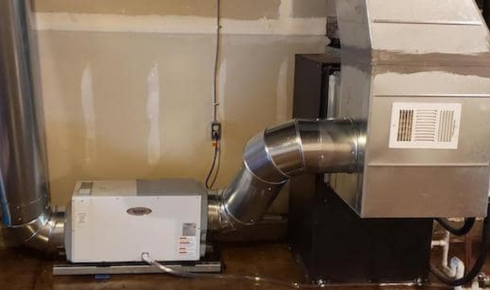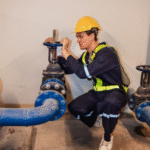There’s something almost invisible about humidity. You can’t see it, but it sneaks into your home, settles into corners, clings to walls, and slowly starts making life a bit less comfortable. Maybe your wood floors feel a little sticky in the summer, or your basement smells musty after a rainstorm. Perhaps your walls have started showing faint patches of mold. These subtle annoyances are easy to ignore, but over time, they can become serious issues. That’s when a good dehumidifier makes all the difference.
I learned this the hard way a few summers ago. My basement seemed fine at first, but after a particularly rainy stretch, I noticed a persistent damp smell and tiny black spots along the corner of the room. After some research, I realized a professional ehumidifier installation could save not just the basement, but potentially prevent damage to the entire home.
Why Humidity Matters
Humidity levels in your home affect more than comfort—they affect health, furniture, and even your energy bills. Excess moisture encourages mold and mildew growth, which can aggravate allergies and respiratory issues. Wooden furniture and flooring can warp, paint can bubble, and metal fixtures may start to rust. High humidity can also make air feel warmer than it actually is, forcing your AC to work harder and driving up energy costs.
On the other end of the spectrum, overly dry air can be just as uncomfortable. It can lead to dry skin, static electricity, and even irritate nasal passages. Finding balance is key, and that’s where dehumidifiers—or, in some cases, whole-home systems—come into play.
What a Whole Home Dehumidifier Can Do
Many people first think of small, portable units, but a whole home dehumidifier offers a different level of convenience and efficiency. These systems connect directly to your home’s HVAC, drawing moisture out from every corner of the house. It’s like having invisible maintenance that constantly works in the background.
The benefits are substantial. Not only does it reduce visible signs of dampness, but it also prevents mold growth, protects furnishings, and helps maintain consistent humidity levels throughout your home. For people with allergies or asthma, the difference can be life-changing. Imagine finally being able to breathe comfortably in your own home during the peak of summer, without that sticky, oppressive feeling lingering in every room.
Portable vs. Built-In Systems
Portable dehumidifiers are great for small spaces, basements, or temporary solutions. They’re convenient, relatively inexpensive, and easy to move from room to room. However, if you’re dealing with widespread humidity issues or want a long-term solution, built-in systems—or whole-home units—tend to be more efficient and less intrusive.
Built-in systems work quietly in the background and require less attention than moving around portable units. They often tie into your HVAC, meaning the air in your entire home is treated. While the initial investment is higher, the benefits—consistent comfort, lower risk of mold, and potential energy savings—make them worthwhile.
Understanding Dehumidifier Systems
Dehumidifiers come in several types, each suited to different needs. Some use refrigeration to condense moisture, while others rely on desiccants that absorb water. Commercial-grade dehumidifier systems often combine methods and are designed to manage large spaces or specific conditions like basements prone to flooding.
Understanding the type of system you need helps you make smarter choices. For example, if your main concern is seasonal humidity in the living areas, a whole-home solution integrated with your HVAC might be ideal. If it’s a small basement or attic, a portable or standalone unit may be enough. In either case, the goal is consistent, controlled humidity.
Installation: Why Professional Matters
Dehumidifier installation might seem straightforward, but professional guidance can save a lot of headaches. Proper sizing, placement, and connection to your home’s HVAC system are critical to ensure efficiency and avoid future maintenance issues. Professionals assess your home’s layout, typical moisture levels, and potential problem areas before recommending the right system.
A carefully planned ehumidifier installation ensures that your home achieves optimal humidity levels without wasting energy. It’s an upfront investment in comfort, health, and peace of mind. Plus, professionally installed systems often come with maintenance plans, making ongoing care much simpler.
Everyday Benefits You Might Not Expect
People often notice immediate improvements after installing a quality dehumidifier, but the benefits go beyond obvious moisture reduction:
- Healthier air quality: Less mold and dust mites mean fewer allergy triggers and a healthier living environment.
- Protecting your home: Wood, paint, and drywall last longer when humidity is controlled.
- Energy efficiency: Drier air feels cooler, allowing your AC to run less frequently.
- Comfort: Clothes dry faster, floors feel more comfortable, and rooms smell fresher.
It’s subtle at first, but over time, it transforms the home environment into something that just feels… right.
Maintenance and Longevity
Even the best dehumidifiers need care. Regular cleaning of filters, checking drainage, and monitoring humidity levels are essential to keep systems running smoothly. Built-in systems often have indicators or alerts, but portable units require more hands-on attention.
For whole-home systems, routine professional check-ups ensure longevity and efficiency. Neglecting maintenance can reduce performance, increase energy costs, and allow humidity problems to resurface. Think of it like servicing your car—occasional attention prevents bigger, more expensive problems down the line.
Seasonal Considerations
Humidity isn’t constant. It fluctuates with seasons, weather, and even activities like cooking or showering. Having a system that adjusts to these changes is critical. Some advanced dehumidifiers automatically regulate output based on sensors placed around the home. This means you maintain consistent comfort year-round without constant adjustments.
Even a portable unit benefits from seasonal awareness. Running it more during humid summer months and scaling back in drier seasons maximizes efficiency and extends the unit’s lifespan.
Investing in Comfort and Safety
The more I lived with a proper dehumidifier system, the more I appreciated the quiet, invisible way it changed daily life. No more musty basements, no more sticky floors, no more constant worry about mold in corners. The investment in a whole home dehumidifier or a professionally installed unit paid for itself not only in comfort but in protecting the structure and longevity of the home itself.
It’s easy to overlook humidity, but once you’ve experienced the difference, it’s hard to imagine going back. Clothes dry faster, the air feels fresher, and the home seems cleaner overall.
Final Thoughts
Humidity may be invisible, but its impact is very real. Whether you’re considering a simple portable unit or a fully integrated system, investing in proper dehumidification transforms your home environment. Professional ehumidifier installation, paired with the right system, ensures that you achieve the ideal balance of comfort, efficiency, and long-term protection.
Understanding the benefits of different dehumidifier systems helps you make informed choices that suit your space, budget, and lifestyle. From healthier air to energy savings, the difference is noticeable—quiet, subtle, and profoundly valuable.
If you’ve ever lived in a sticky, musty, or mold-prone home, you know the frustration all too well. Investing in humidity control isn’t just about comfort—it’s about creating a home that feels fresh, safe, and just right every single day.



